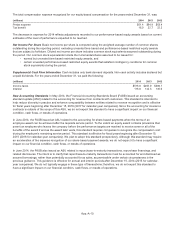Progressive 2014 Annual Report Download - page 21
Download and view the complete annual report
Please find page 21 of the 2014 Progressive annual report below. You can navigate through the pages in the report by either clicking on the pages listed below, or by using the keyword search tool below to find specific information within the annual report.INTEREST RATE SWAPS
We use interest rate swap contracts primarily to manage the fixed-income portfolio duration. At December 31, 2014, 2013,
and 2012, we held interest rate swap positions for which we are paying a fixed rate and receiving a variable rate, effectively
shortening the duration of our fixed-income portfolio. On the open positions, since inception, interest rates have increased;
however, as interest rates fell during 2014, our fair value gain decreased by $52.3 million.
During 2013, we closed three interest rate swap positions including a 9-year interest rate swap position (opened in 2009)
and two 5-year interest rate swap positions (opened in 2011); in each case, we were paying a fixed rate and receiving a
variable rate, effectively shortening the duration of our fixed-income portfolio.
As of December 31, 2014 and 2013, the balance of the cash collateral that we had received from the applicable
counterparty on our open positions was $16.1 million and $62.7 million, respectively. As of December 31, 2012, the balance
of the cash collateral that we had delivered to the applicable counterparty on the then open positions was $105.0 million.
CORPORATE CREDIT DEFAULT SWAPS
We held no credit default swaps during 2014 or 2013. During 2012, we closed one position that was opened during 2008,
on a corporate issuer within the financial services sector for which we bought credit default protection in the form of a credit
default swap for a 5-year time horizon. We held this protection to reduce our exposure to additional valuation declines on a
preferred stock position of the same issuer.
3. FAIR VALUE
We have categorized our financial instruments, based on the degree of subjectivity inherent in the method by which they are
valued, into a fair value hierarchy of three levels, as follows:
•Level 1: Inputs are unadjusted, quoted prices in active markets for identical instruments at the measurement date
(e.g., U.S. government obligations, active exchange-traded equity securities, and certain short-term securities).
•Level 2: Inputs (other than quoted prices included within Level 1) that are observable for the instrument either
directly or indirectly (e.g., certain corporate and municipal bonds and certain preferred stocks). This includes:
(i) quoted prices for similar instruments in active markets, (ii) quoted prices for identical or similar instruments in
markets that are not active, (iii) inputs other than quoted prices that are observable for the instruments, and
(iv) inputs that are derived principally from or corroborated by observable market data by correlation or other
means.
•Level 3: Inputs that are unobservable. Unobservable inputs reflect our subjective evaluation about the
assumptions market participants would use in pricing the financial instrument (e.g., certain structured securities
and privately held investments).
Determining the fair value of the investment portfolio is the responsibility of management. As part of the responsibility, we
evaluate whether a market is distressed or inactive in determining the fair value for our portfolio. We review certain market
level inputs to evaluate whether sufficient activity, volume, and new issuances exist to create an active market. Based on
this evaluation, we concluded that there was sufficient activity related to the sectors and securities for which we obtained
valuations.
App.-A-20
























